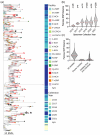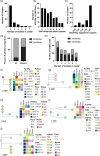Genomic analysis of Candida auris transmission within an urban region
- PMID: 40928209
- PMCID: PMC12452193
- DOI: 10.1099/mgen.0.001478
Genomic analysis of Candida auris transmission within an urban region
Abstract
Candida auris emerged in Chicago, IL, USA, in 2016 and has since become endemic. We used whole-genome sequencing (WGS) of 494 isolates, epidemiologic metadata and patient transfer data to describe the transmission of C. auris among Chicago healthcare facilities between 2016 and 2021. In total, 99% of isolates formed a single clade IV phylogenetic lineage, suggesting a single introduction. The remaining isolates were clade III. Isolates were grouped into genomic clusters based on phylogenetic clustering and relatedness. Isolates from 14 facilities were included in 77 genomic clusters with evidence of inter- and intra-facility transmission; 62% of isolates included in genomic clusters clustered with another from the same facility. Patient transfer data corroborated transmission among facilities in large genomic clusters, and patient transfers between facilities correlated with more similar genomes. In total, 30% of individuals who had serial samples collected over time had isolates collected during different facility stays. Most of these individuals carried closely related isolates over time, although 25% carried isolates whose genomes diverged. Integrating WGS data and patient metadata to describe inter- and intra-facility clusters revealed regional transmission patterns within and between healthcare facilities that could be used to guide targeted interventions to prevent transmission. Given that patient transfer data were concordant with WGS analysis, they may serve as a predictive tool for risk of inter-facility transmission.
Keywords: Candida auris; fungal pathogens; genomic epidemiology; healthcare associated infections; phylogenetics; whole-genome sequencing.
Conflict of interest statement
The authors declare that there are no conflicts of interest.
Figures






References
-
- Chicago Department of Public Health Candida auris Data Summary – Chicago, IL. 2024 https://www.chicagohan.org/documents/d/han/epi-summary-of-candida-auris-...
-
- Centers for Disease Control and Prevention Candida auris (C. auris) 2024. https://www.cdc.gov/candida-auris/about/index.html
-
- Sexton DJ, Bentz ML, Welsh RM, Derado G, Furin W, et al. Positive correlation between Candida auris skin-colonization burden and environmental contamination at a ventilator-capable skilled nursing facility in Chicago. Clin Infect Dis. 2021;73:1142–1148. doi: 10.1093/cid/ciab327. - DOI - PMC - PubMed
MeSH terms
Grants and funding
LinkOut - more resources
Full Text Sources
Medical

